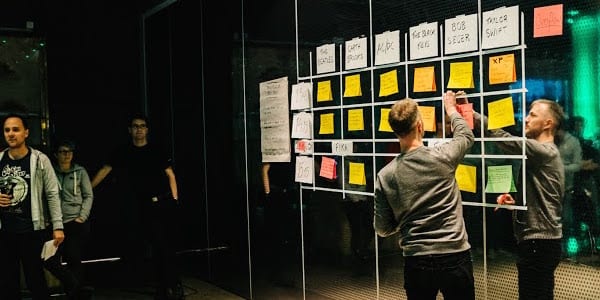
The depth of Lean Thinking
FEATURE – To really embrace lean thinking means to ensure the bureaucratic structures in our organizations enable our people to excel, rather than constrain their creativity.
Words: Michael Ballé, lean author, executive coach and co-founder of Institut Lean France.
I remember a presentation by Toyota veteran Tatsuhiko Yoshimura stating something like, “All jobs must add value to the products all the time.” Business is about making profits by applying creative knowledge and skill of engineers and technicians to products. “To find problems,” Yoshimura-san continued, “is the first step of adding value. We need to utilize our creativity to find problems.” Italics mine.
It’s taken me years – decades, in fact – of studying lean, the Toyota Production System and mainstream management to start to grasp how different lean is as a foundation to how we go about managing. In traditional management, it seems obvious that high-performing organizations have (somehow) discovered “best practice” and that the manager’s job is to acquire these practices, implement them and thus reach superior performance.
Toyota’s thinking is that practices are built on finding problems, coming up with countermeasures, studying these countermeasures and enriching processes from the knowledge gained, applied creatively according to context – the notion of “yokoten” as copy plus improve rather than acquire plus apply. In this way of seeing things, applying best practices doesn’t make much sense since the conditions and difficulties will never be the same from one case to the next (being curious and inspiring oneself from what others do is smart, but expecting to purchase it – or even “adapt” it – and apply it isn’t).
The whole TPS system is in fact a set of practices to better reveal problems and better work with people to solve them by aiming to improve customer satisfaction every day, reducing lead-time, reacting faster to quality issues, supporting the people facing the problem, and building cooperation and mutual trust at all levels through solving problems and improving things together – “adding value” in Toyota’s terms. But although the lean system excels at unearthing problems, it only does so if people seek “bad news first” and then try their best to solve the problems, and do so by engaging with others across functional boundaries.
This radically redefines management’s role from defining situations, deciding on solutions, driving these through disciplined execution, and then dealing with the unforeseen consequences, to supporting employees in finding problems, facing them (particularly when they seem to have no solution), framing them in a way that their colleagues can understand and participate, and forming overall solutions from everyone’s local countermeasures.
The underlying assumptions about the world and our limited understanding of it are close to scientific thinking:
• We’ll never know everything (mostly because our minds are too small and external change is faster than changes in our understanding);
• There are correct solutions to problems, but these remain largely unknown and are there to be discovered;
• However, through constant self-challenge, on-site learning and problem solving,
• We can better grasp our knowledge gaps, work on them creatively, and build on people’s talent to come up with better ways, for customers, for employees, and for the environment – sustainably (step by step) and profitably (by eliminating waste).
As a manager, this view is challenging because it demands abandoning “do it this way, or else,” and adopting “let’s figure this out together.”
TURNING BUREAUCRACY ON ITS HEAD
The corporate bureaucracies we’ve built are compliance machines: the all-knowing leader makes critical decisions, tasks expert staff with defining the process to “make it so”, and middle managers are expected to have front-line employees apply. Everyone is rewarded on both how closely their numbers fit targets as they are monitored and how much effort they put into applying the prescribed processes.
Now, obviously, things at the coal face are never as expected, and the only way to keep the boss happy is to come up with action plans detailing how complying better will deliver the asked-for results, and then finding the right explanations or people to blame when reality stubbornly refuses to relent. Not surprisingly, the people involved understand how absurd the game is and let go of technical issues to only focus on internal politics: who has which leader’s ear, who is fighting with whom, who to support, who to betray, when to keep your head down, when to speak up, how to survive long enough to keep progressing up the corporate ladder.
Bureaucratic environments of roles, rules, monitoring, systems and rewards-for-performance have yielded a theory of motivation opposing extrinsic motivation (working for approval, bonuses and promotions) from intrinsic motivation (a sense of meaning to one’s job, working for interest in the work and to contribute creative solutions and helpful changes). Leaders typically double-bind their employees by rewarding enforcement of functional separation, existing processes, legacy systems (reinforcing extrinsic motivators) then demanding greater responsibility, innovation and initiative (typically born of intrinsic motivation). This is fundamentally perverse, and only compounds bureaucratic red-tape.
With lean, these dichotomies suddenly appear as false. We strive to solve problems for customers and employees, and be rewarded by smiles, both from customers and teams – this is extrinsic motivation. But we do so by challenging ourselves to better grasp the facts of the real situation, first-hand, to come up with more insightful analyses, more practical and appropriate initiatives and then think creatively about what reality tells us every time we try something different – intrinsic motivation.
Motivation, in lean, rests on confidence: confidence that we’ll obtain results from looking for the right methods, confidence that we know what we know (standards), confidence that we can explore what we don’t (problem solving and kaizen), confidence in our team and management (bad news, unfavorable information is interesting and welcome as the fundamental source of progress), and so confidence that we can face our overarching challenges together, and that we each have a creative role to play in this effort.
LEADERSHIP CHANGES THAT TRANSFORM ORGANIZATIONS
Lean thinking teaches us that we shouldn’t try to replace bureaucracy with a better organizational model, whether holacracies or AI-driven networks. Bureaucracies are deeply woven into the fabric of our society because of their ability to scale and overall stability. We simply can’t do without them, but they have well-known, often-crippling flaws. The core problem is that the bureaucratic system of rules, targets, monitoring and rewards tends to select executives who are better at gaming the system than supporting its purpose. Executives who, with their own advancement clearly in sight, gain points by pushing their specialist agendas and surround themselves with enforcers, choosing functional outputs over customer outcomes and preferring people who fit the narrow job description to the talent to change things and find a better way.
Lean demands two deep changes from our leaders. First, awareness: realizing they don’t have all the answers and that they must constantly challenge their own beliefs according to new information and new developments rather than cherry pick the news and fit everything into their existing mental framework. Secondly, greater thoughtfulness and understanding that who’s in the bus matters disproportionately because real-life countermeasures will be found by the people themselves, not in the boardroom.
Awareness and thoughtfulness are intrinsically linked to greater responsiveness: when a child leans into a well, first you need to see it – awareness – and then to respond quickly in the correct way not to spook them – thoughtfulness. Awareness is about asking ourselves “what is the game?” Thoughtfulness: “how do we play it?” But both can only be developed by responsiveness: try-see-think, try-see-think. And then: what next?
By understanding this from their own experience, leaders can work at creating the conditions to develop greater awareness and thoughtfulness in everybody. Any person can be asked about their job’s purpose, the problems for their customers, for their colleagues, the understanding of the causes of these problems, the countermeasures currently attempted, and their own learning from trying out these countermeasures, and deepening of their understanding.
For a leader, this is a huge developmental step in learning to manage the conditions of success by establishing a learning system and letting managers and team leaders tackle causes one by one.
Lean is not revolutionary in the sense that we will break the old system and replace it with a new, braver, better one. It is, however, transformational in the sense of changing one’s relationship with one’s work. Developing greater responsiveness, awareness and thoughtfulness in one’s job means also developing responsiveness, awareness and thoughtfulness in one’s role in society at large.
This is a very concrete change. The leader of a large maintenance operation with very visible results from lean (improvements on all fronts of safety, quality, delivery, productivity and employee morale) described his learning as: “I used to believe management was calling the shots and kicking ass until people did the job as I wanted it done. I still do that occasionally, but I now realize that every time I do, I create the very resistance I’m trying to fight. When I spend the time explaining more clearly the gains I seek (which means being clear about these gains in the first place, and why they are gains and for whom), listening to the concrete obstacles people face, observing with people, shoulder to shoulder, exploring technical problem solving and then supporting initiatives and discussing their outcomes, somehow, results improve every time, and people come up with the most amazing ideas. For real.”
When I first started studying lean, I remember another Toyota veteran who did an entire talk with one single slide (they were real slides at the time, projected on screens). “THINK DEEPLY,” it said.
In the lean movement as much as anywhere else, there is a natural tendency to interpret lean techniques in the service of bureaucracies: fix the problem, standardize the process, manage the performance, apply the ten commandments of “lean” (or “six sigma” or whatever) to make people do this or that. This is what bureaucratic middle-managers ask for and what many lean consultants deliver. Everyone has to make a living, but this leads us to assimilate lean to the mainstream model of targets, monitoring, consequences, and achieving narrow outputs, rather than change our minds to adopt real lean thinking.
The deeper commitment to lean thinking stems from understanding that bureaucracies can indeed work and delivery better outcomes for all of us. But to do so we need to teach them to support and enable individuals, not repress and constrain. The lean learning system as pioneered by Toyota is meant to do exactly that, if understood in this light. Interpreted as operations management, it devolves into yet one more way of squeezing local results at the expense of overall performance and long-term competitiveness.
I took my first real lesson in lean when I was told that “in order to make products, first you have to make people.” But you don’t make people the way you make things: people are not machines to be set. You “make” people by challenging them and encouraging their curiosity in their field, their engagement with their work and their involvement with their teams and their company. You make people by developing their sense of competence and caring, which involves them seeing you as competent and caring in the first place. You make people by making them proud of working where they work and how they work. I am not talking about the blind, silly pride of “we’ve always done it this way”, but about the pride of “we achieve results by working very hard at understanding what happens out there, and making changes one by one until we better master what we do.”
We are proud to each add value, not just produce value. And this starts with relying on responsiveness to first developing awareness, taking upon ourselves to find problems, and then developing thoughtfulness, being serious about how we will solve them concretely with others, and learning from the experimentation process until we see root causes and deepen our understanding of conditions. The thoughtfulness of quick next step, and next step, until we figure it out. The thoughtfulness of real learning-by-doing. To change the world, first we need to change ourselves.
THE AUTHOR

Read more


INTERVIEW – One of the world's largest dairy cooperatives, FrieslandCampina, has embarked on an ambitious global lean journey. Along the way, they found how critical leadership engagement is.


FEATURE – This article offers an exhaustive explanation of how to prepare a Concept Paper and why this is a tool that will help us to succeed in the execution of large change projects.


CASE STUDY - How Spotify developed an alternative management system based on servant leadership, interaction-based learning and adaptability – changing the music industry along the way.


WEB SERIES - In this episode, we head to Chilean Patagonia to visit a manufacturer of fish feed that turned to Lean Thinking to improve yield and eliminate inventory gaps and stock-outs.

